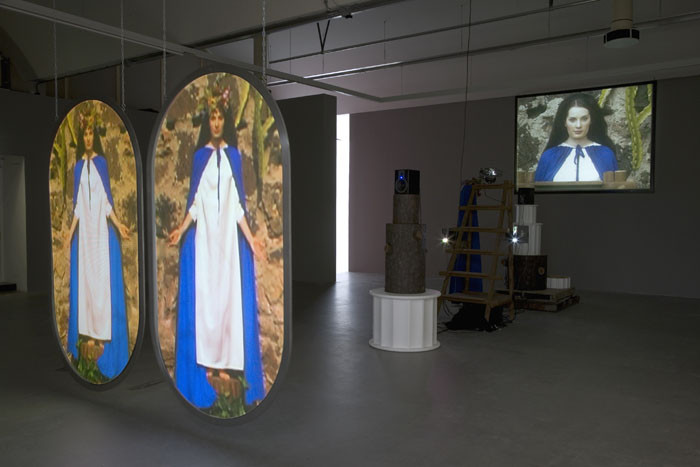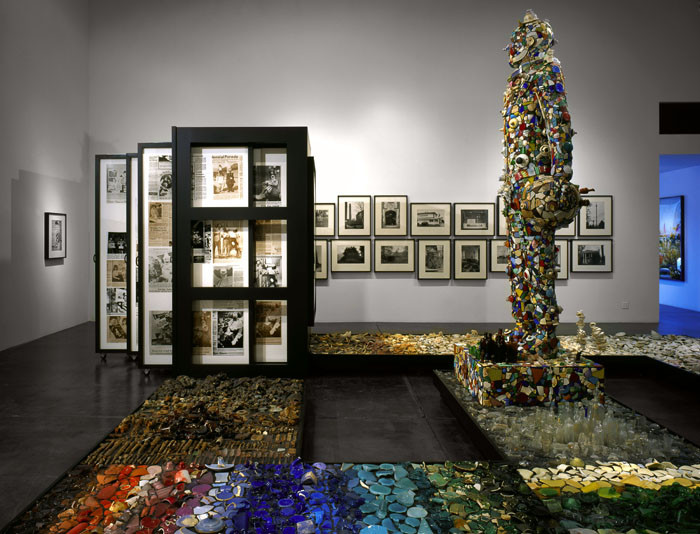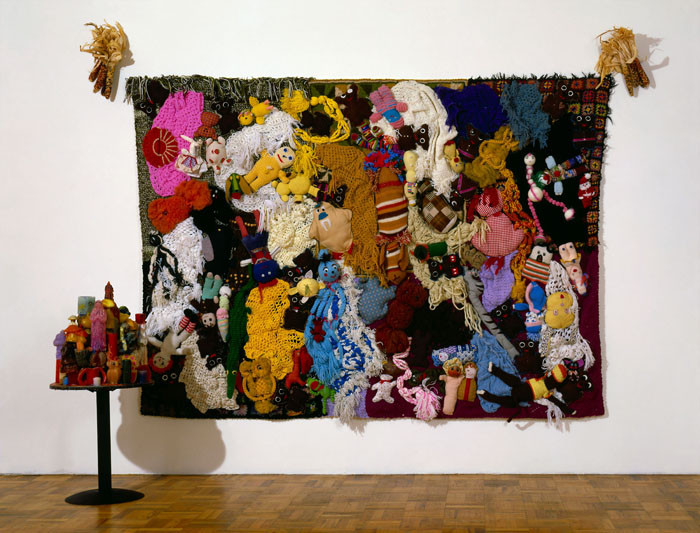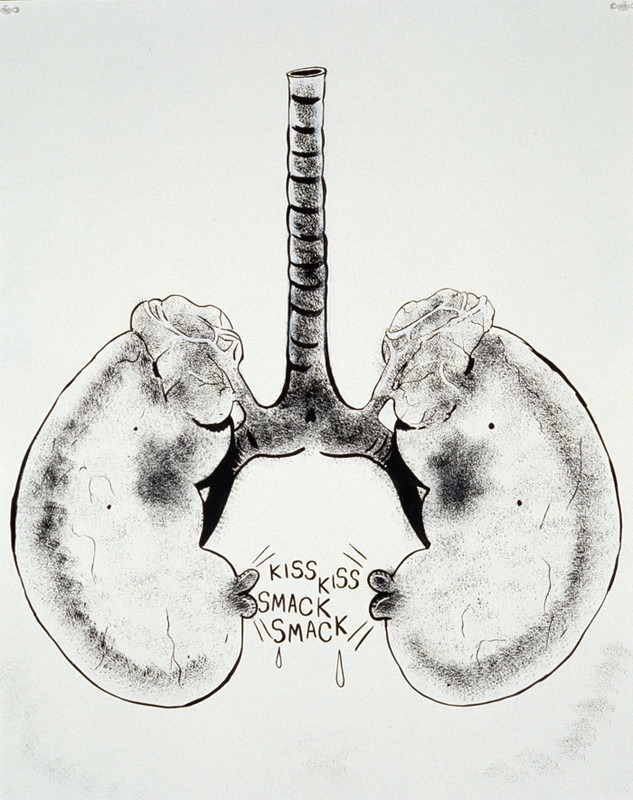Mike Kelley
15 Dec 2012 - 01 Apr 2013

Mike Kelley
Wayne, MI (US), 1954 - South Pasadena, CA (US), 2012
From My Institution to Yours
1987/2003
Installation view, 493 x 474 x 314 cm
Collection Eric Decelle, Brussels
Photo: Courtesy Mike Kelley Foundation for the Arts
Wayne, MI (US), 1954 - South Pasadena, CA (US), 2012
From My Institution to Yours
1987/2003
Installation view, 493 x 474 x 314 cm
Collection Eric Decelle, Brussels
Photo: Courtesy Mike Kelley Foundation for the Arts

Mike Kelley
Wayne, MI (US), 1954 - South Pasadena, CA (US), 2012
Switching Marys
2004-2005
Mixed media with video projections, 190,5 x 261,6 x 810,3 cm
Stedelijk Museum, Amsterdam
Photo: Fredrik Nilsen, Courtesy Mike Kelley Foundation for the Arts
Wayne, MI (US), 1954 - South Pasadena, CA (US), 2012
Switching Marys
2004-2005
Mixed media with video projections, 190,5 x 261,6 x 810,3 cm
Stedelijk Museum, Amsterdam
Photo: Fredrik Nilsen, Courtesy Mike Kelley Foundation for the Arts

Mike Kelley
Wayne, MI (US), 1954 - South Pasadena, CA (US), 2012
Pay For Your Pleasure
1988
Installation view, dimensions variable
The Museum of Contemporary Art, Los Angeles; Gift of Timothy P. and Suzette L. Flood
Photo: Courtesy Mike Kelley Foundation for the Arts
Wayne, MI (US), 1954 - South Pasadena, CA (US), 2012
Pay For Your Pleasure
1988
Installation view, dimensions variable
The Museum of Contemporary Art, Los Angeles; Gift of Timothy P. and Suzette L. Flood
Photo: Courtesy Mike Kelley Foundation for the Arts

Mike Kelley
Wayne, MI (US), 1954 - South Pasadena, CA (US), 2012
John Glenn Memorial Detroit River Reclamation Project (Including the Local Culture Pictorial Guide, 1968-1972, Wayne Westland Eagle)
2001
Installation view, 345,5 x 548,7 x 632,5 cm
Rennie Collection, Vancouver
Photo: Fredrik Nilsen, Courtesy Mike Kelley Foundation for the Arts
Wayne, MI (US), 1954 - South Pasadena, CA (US), 2012
John Glenn Memorial Detroit River Reclamation Project (Including the Local Culture Pictorial Guide, 1968-1972, Wayne Westland Eagle)
2001
Installation view, 345,5 x 548,7 x 632,5 cm
Rennie Collection, Vancouver
Photo: Fredrik Nilsen, Courtesy Mike Kelley Foundation for the Arts

Mike Kelley
Wayne, MI (US), 1954 - South Pasadena, CA (US), 2012
More Love Hours Than Can Ever Be Repaid and The Wages Of Sin
1987
Stuffed fabric toys on afghans on canvas with dried corn; wax candles on wood and metal base, 243,8 x 322,6 x 15 cm and 132 x 58 x 58 cm
Whitney Museum of American Art, New York; Purchase with funds from the Painting and Sculpture Committee
Photo: Courtesy Mike Kelley Foundation for the Arts
Wayne, MI (US), 1954 - South Pasadena, CA (US), 2012
More Love Hours Than Can Ever Be Repaid and The Wages Of Sin
1987
Stuffed fabric toys on afghans on canvas with dried corn; wax candles on wood and metal base, 243,8 x 322,6 x 15 cm and 132 x 58 x 58 cm
Whitney Museum of American Art, New York; Purchase with funds from the Painting and Sculpture Committee
Photo: Courtesy Mike Kelley Foundation for the Arts

Mike Kelley
Wayne, MI (US), 1954 - South Pasadena, CA (US), 2012
Animal Self and Friend of Animal
1987
Glued felt, 2 parts, 241 x 172 cm and 244 x 183 cm
The Schyl Collection, Malmö Kontshall
Photo: Helene Toresdotter, Courtesy Mike Kelley Foundation for the Arts
Wayne, MI (US), 1954 - South Pasadena, CA (US), 2012
Animal Self and Friend of Animal
1987
Glued felt, 2 parts, 241 x 172 cm and 244 x 183 cm
The Schyl Collection, Malmö Kontshall
Photo: Helene Toresdotter, Courtesy Mike Kelley Foundation for the Arts

Mike Kelley
Wayne, MI (US), 1954 - South Pasadena, CA (US), 2012
Banana Man Costume
1981
lifesize
Mike Kelley Foundation for the Arts
Photo: Courtesy Mike Kelley Foundation for the Arts
Wayne, MI (US), 1954 - South Pasadena, CA (US), 2012
Banana Man Costume
1981
lifesize
Mike Kelley Foundation for the Arts
Photo: Courtesy Mike Kelley Foundation for the Arts

Mike Kelley
Wayne, MI (US), 1954 - South Pasadena, CA (US), 2012
Dancing the Quadrille (from the Reconstructed History Series)
1989
Gelatin silver print, 20,3 x 25,4 cms
Eileen and Michael Cohen Collection
Photo: Courtesy Mike Kelley Foundation for the Arts
Wayne, MI (US), 1954 - South Pasadena, CA (US), 2012
Dancing the Quadrille (from the Reconstructed History Series)
1989
Gelatin silver print, 20,3 x 25,4 cms
Eileen and Michael Cohen Collection
Photo: Courtesy Mike Kelley Foundation for the Arts

Mike Kelley
Wayne, MI (US), 1954 - South Pasadena, CA (US), 2012
Kissing Kidneys
1989
Acrylic on paper, 102,2 x 81,3 cm
Ringier Collection
Photo: Courtesy Mike Kelley Foundation for the Arts
Wayne, MI (US), 1954 - South Pasadena, CA (US), 2012
Kissing Kidneys
1989
Acrylic on paper, 102,2 x 81,3 cm
Ringier Collection
Photo: Courtesy Mike Kelley Foundation for the Arts

Mike Kelley
Wayne, MI (US), 1954 - South Pasadena, CA (US), 2012
Janitorial Banner
1984
Glued felt, wood, h. 125 cm overall
Collection of Joel Wachs
Photo: Courtesy Mike Kelley Foundation for the Arts
Wayne, MI (US), 1954 - South Pasadena, CA (US), 2012
Janitorial Banner
1984
Glued felt, wood, h. 125 cm overall
Collection of Joel Wachs
Photo: Courtesy Mike Kelley Foundation for the Arts
MIKE KELLEY
15 December 2012 — 1 April 2013
Widely acknowledged as an artist who defined his era, Mike Kelley (1954–2012) created a stunning and protean legacy that encompasses painting, sculpture, works on paper, installation, performance, music, video, photography, collaborative works and critical texts. In the largest exhibition of his work ever organized—and the first comprehensive survey attempted since 1993—the Stedelijk Museum Amsterdam presentation of Mike Kelley will bring together over 200 works, spanning the artist’s 35-year career.
This exhibition is organized by Ann Goldstein (Stedelijk Museum Director), in cooperation with the Mike Kelley Foundation for the Arts. Curator of the first exhibition concept is Dr. Eva Meyer-Hermann.
The first major international traveling exhibition to be organized and presented by the Stedelijk since its expansion and renovation, Mike Kelley will subsequently travel to the Centre Pompidou, Paris, MoMA PS1, New York, and the Museum of Contemporary Art, Los Angeles.
The curator of the first exhibition concept is Dr. Eva Meyer-Hermann. The exhibition took on a new significance following the artist’s tragic death in early 2012. “After Mike Kelley’s death, his remarkable oeuvre was suddenly complete, and so this exhibition, which was being planned with his direct participation, became a retrospective in the full sense of the word,” Ann Goldstein stated. “We now have the responsibility to begin to think about his voluminous, wide-ranging, generative accomplishments as a completed body of work. I know that the process of discovery and reconsideration that we begin at the Stedelijk will surely be taken up by other curators, historians and institutions, extending far into the future.”
Organized chronologically for the most part, Mike Kelley will fill virtually all of the 1792-square-meter (19.289-square-foot) temporary exhibition space in the new building of the expanded Stedelijk Museum. The exhibition will constitute an overview of the artist’s work from the mid-1970s until shortly before his death, allowing visitors to understand and appreciate the full scope of his achievements.
“Mike Kelley's brilliance was rooted in his ability to dig critically into a world of cultural productions, representations, and constructions in all their messy contradictions, using a combination of incisive wit, poetic insight and uncanny associative power,” Ann Goldstein commented. “Nothing is sacrosanct in his work—not so-called high culture, history, literature, music, philosophy, psychology, religion or education. In bringing together his interest in so-called low culture—from crafts to comic strips—with a reconsideration of identity and sexuality, he was nothing less than revelatory.”
15 December 2012 — 1 April 2013
Widely acknowledged as an artist who defined his era, Mike Kelley (1954–2012) created a stunning and protean legacy that encompasses painting, sculpture, works on paper, installation, performance, music, video, photography, collaborative works and critical texts. In the largest exhibition of his work ever organized—and the first comprehensive survey attempted since 1993—the Stedelijk Museum Amsterdam presentation of Mike Kelley will bring together over 200 works, spanning the artist’s 35-year career.
This exhibition is organized by Ann Goldstein (Stedelijk Museum Director), in cooperation with the Mike Kelley Foundation for the Arts. Curator of the first exhibition concept is Dr. Eva Meyer-Hermann.
The first major international traveling exhibition to be organized and presented by the Stedelijk since its expansion and renovation, Mike Kelley will subsequently travel to the Centre Pompidou, Paris, MoMA PS1, New York, and the Museum of Contemporary Art, Los Angeles.
The curator of the first exhibition concept is Dr. Eva Meyer-Hermann. The exhibition took on a new significance following the artist’s tragic death in early 2012. “After Mike Kelley’s death, his remarkable oeuvre was suddenly complete, and so this exhibition, which was being planned with his direct participation, became a retrospective in the full sense of the word,” Ann Goldstein stated. “We now have the responsibility to begin to think about his voluminous, wide-ranging, generative accomplishments as a completed body of work. I know that the process of discovery and reconsideration that we begin at the Stedelijk will surely be taken up by other curators, historians and institutions, extending far into the future.”
Organized chronologically for the most part, Mike Kelley will fill virtually all of the 1792-square-meter (19.289-square-foot) temporary exhibition space in the new building of the expanded Stedelijk Museum. The exhibition will constitute an overview of the artist’s work from the mid-1970s until shortly before his death, allowing visitors to understand and appreciate the full scope of his achievements.
“Mike Kelley's brilliance was rooted in his ability to dig critically into a world of cultural productions, representations, and constructions in all their messy contradictions, using a combination of incisive wit, poetic insight and uncanny associative power,” Ann Goldstein commented. “Nothing is sacrosanct in his work—not so-called high culture, history, literature, music, philosophy, psychology, religion or education. In bringing together his interest in so-called low culture—from crafts to comic strips—with a reconsideration of identity and sexuality, he was nothing less than revelatory.”
